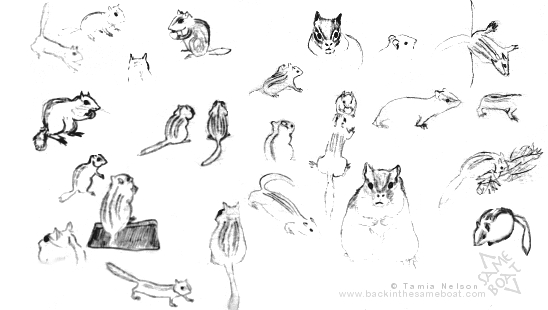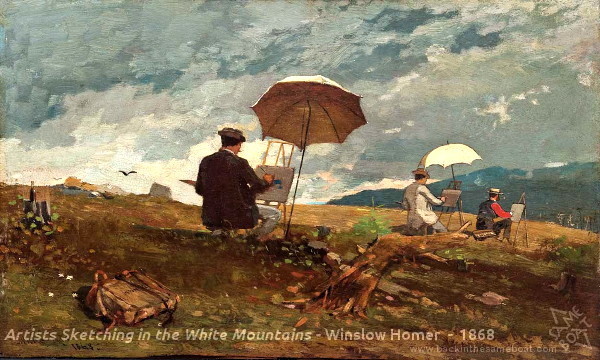Learning to See
Happy Are the Painters
When a Christmas Eve fire left Tamia with little more than the clothes on her back, she mourned the loss of her camera and photos. But out of this loss came something of enduring value: She learned to see again. And so can you.
______________________________
by Tamia Nelson | March 23, 2018
Originally published in very different form on June 6, 2000

Nearly forty years ago, Farwell and I made our first home together in what had once been the servants’ quarters of an imposing Victorian manse. Then, on Christmas Eve, the century-old structure burned to the ground. As luck would have it, we were away from home at the time, visiting family, but we didn’t escape unscathed. Except for an aging Volkswagen Beetle and the clothes on our backs, the flames consumed everything we owned.
This blow fell hard on us. We had no insurance, for one thing. Still, although we missed our tent, our sleeping bags, our climbing gear, and our books, the losses I felt most keenly were my treasured Nikon camera and my collection of photographic slides and prints, a collection which had filled dozens of steel boxes. From the time I was given my first camera at the age of 10, I’d wanted to be a professional photographer. But on that terrible Christmas Day, as Farwell and I raked through the smoldering rubble for hours, salvaging only a single, discolored Sierra Club cup for our trouble, I realized just how distant that dream had now become.
Nor was this my only regret. My photographs had become my memory. They were my only tangible remembrance of absent friends, of wild creatures seen only once, and of mountain tarns and river valleys I would probably never visit again. I knew I could replace my camera. But the photographs from my past life were irretrievably lost.
Yet when I finally scraped together enough money to buy a new camera, I found that my enthusiasm for photography had waned. In the long years between cameras, I’d rediscovered something that I hadn’t even known I’d lost. I’d started drawing again. As a child, I was seldom without a pencil in my hand. From my earliest days onward, I’d felt a compulsion to capture the fleeting moment, to reduce it to my possession and to make it mine forever. And so, armed only with pencil stubs and scraps of paper, I’d stalked my prey—the ephemeral frontier of the present moment—with as much determination as any other hunter.
Once I got my first camera, however, I put all this behind me. The camera was wonderfully easy to use, and the resulting images were reassuringly true to life. (Back then, you could still say “The camera never lies” and be believed.) There was a comforting ritual about photography, too. After picking up my newly developed prints at the local drugstore, I’d unwrap them from their protective envelope with all the ceremony usually reserved for opening packages on Christmas morning. And the photos themselves? Well, I was no Ansel Adams, to be sure, but I thought my snapshots were wonderful—nothing at all like my pencil sketches, with their awkward proportions and uncertain perspective.
Photography was effortless. It was fun. And it captured each passing moment with absolute accuracy. In short, I was well and truly hooked. I’d finished with pencil and paper forever. Or so I thought, until one Christmas morning brought, not a happy surprise, but a package of ashes and tears.
The following months were hard. Slowly, Farwell and I replaced the most important of our lost possessions. Long before I’d saved up enough money to buy a camera, however, the urge to capture the moment reasserted itself, and since photography was now out of the question, I picked up a pencil once again. At first, I did so grudgingly, even resentfully. I cursed my bad luck and damned my clumsy, unresponsive fingers. Images that I could have fixed on film in an instant now took me many minutes—sometimes many hours—to record. And the amateurish results never satisfied me. They looked nothing like photographs, and this was a source of endless disappointment.
Nonetheless, I struggled on. The itch was just too strong to resist. I mastered proportion and perspective. Then I began to experiment, first with technical pens and later with watercolor paints, learning how to reproduce the textures of everything from sandstone to surf with nothing more than variable densities of dots and washes of pigment. And slowly, ever so slowly, I learned to see again.
There had been nothing wrong with my eyes, your understand. But a photographer’s view of the world is necessarily constrained. At the critical instant, the final moment just before she presses the shutter, her world is limited to what she sees in her viewfinder or display. And while photographers share many of the concerns of other artists—composition, lighting, and color, to name only three—their interest in these is perhaps more mechanical than personal. The process of shooting pictures is all but automatic. Choose the lens, frame the shot, set aperture and exposure. Then squeeze the shutter. The camera does the rest.
Compare this to the task confronting someone trying to capture an image of a creature as familiar as a chipmunk, with no tool except a pencil. The little animal is in constant motion. The artist has no fast shutter to freeze the action, no long lens to help her “frame the shot.” She can only follow her subject with her eyes, trying to capture the essentials of form, movement, and texture on her mind’s emulsion. She sketches furiously, each sketch a fragment of the final composition. One thumbnail sketch shows the wonderfully adept paw, another the texture of hair on the chipmunk’s flank, another an alert, erect stance seen only in silhouette. And then, before the artist has time to make more than a few such sketches, her subject vanishes from view, disappearing down a previously unseen and unsuspected passage under a mossy stone.
The artist now sets to work in earnest. She has no resources but a handful of rough sketches and her memory. From these she must reproduce the image of a vital and active animal—an image which somehow conveys not only the chipmunk’s form, but also its character and personality.

More often than not, of course, the artist will fail—at least when I’m the artist, she will. But whether or not I succeed in capturing the moment on paper, I’m left with something more: an enduring memory. The scene I’ve sketched—chipmunk, mossy stone, fern, and forest fringe—is now a part of me. I am no longer a passive observer, a mere “framer-of-shots.” Instead, I’m a participant in an extended conversation with the landscape and its inhabitants. The moment in time I sought to capture is now mine for so long as there is a “me” to recall it.
No, I haven’t sold my camera. In fact, I now own three. And I’ve taken literally tens of thousands of shots in the years since our Christmas Eve fire, not counting the thousands of documentary photos I took in the course of my work as a geoarchaeologist.
When I’m paddling for pleasure, though—and what other reason is there for paddling these days?—and when, as often happens, I feel the urge make a visual record of a chance encounter, I no longer reach reflexively for a camera. Instead, I pull out my sketchbook, take pencil in hand, and begin to draw. And as I sketch what I see before me, trying to fix the scene firmly in my memory, I remember the words of another amateur artist who wrote feeling about his own great awakening, more than half a century ago:
One is quite astonished to find how many things there are in the landscape, and in every object in it, one never noticed before. …. And I had lived for over forty years without ever noticing any of them except in a general way, as one might look at a crowd and say, “What a lot of people!” I think this heightened sense of observation of Nature is one of the chief delights that have come to me through trying to paint. … The whole world is open with all its treasures. The simplest objects have their beauty.
The amateur painter who wrote this was Winston Spencer Churchill, by the way. I don’t think he ever held a paddle in his life, but he stands behind me every time I pick up a pencil, pen, or brush and begin to look about me with an inquiring eye.
Perhaps you’ll join us someday. If you do, I don’t think you’ll regret it. “Happy are the painters,” Churchill also wrote, “for they shall not be lonely. Light and colour, peace and hope, will keep them company to the end, or almost to the end, of the day.”
That’s true, I think. There’s a lot to be said for learning to see.


